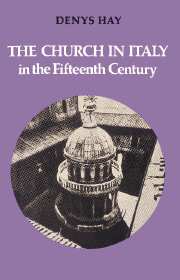Book contents
- Frontmatter
- Contents
- PREFACE
- 1 The problems of Italian church history
- 2 Diocesan and parochial organisation
- 3 The Schism in Italy: the emergence of an Italian papacy
- 4 The state of the clergy and laity in fifteenth-century Italy
- 5 The quality of Italian religious life. Reform
- 6 The Italian Renaissance and the clergy of Italy in the fifteenth century
- APPENDIX
- NOTES
- REFERENCES
- INDEX (NOT INCLUDING APPENDICES)
5 - The quality of Italian religious life. Reform
Published online by Cambridge University Press: 22 October 2009
- Frontmatter
- Contents
- PREFACE
- 1 The problems of Italian church history
- 2 Diocesan and parochial organisation
- 3 The Schism in Italy: the emergence of an Italian papacy
- 4 The state of the clergy and laity in fifteenth-century Italy
- 5 The quality of Italian religious life. Reform
- 6 The Italian Renaissance and the clergy of Italy in the fifteenth century
- APPENDIX
- NOTES
- REFERENCES
- INDEX (NOT INCLUDING APPENDICES)
Summary
Pre-Reformation reform has been much studied in recent years – almost the sole aspect of church life that has been given extensive treatment in later medieval Italy. This is not least, one suspects, because recent changes in the Roman Catholic Church have stressed popular religious movements or the popular element in religious change. Just as conciliarism is now in favour with many highlyplaced ecclesiastics (though by no means all), so confraternities of all sorts, charitable activities of all sorts, the church seen as an element in the social situation in which all men were involved, has led to movements being studied which have been somewhat neglected before, and to a new interest in heretics, especially those Italian heretics who survived the shock waves from the north after the 1520s.
With these last this book is not concerned. But I believe it to be helpful to study the question of reform beginning with reform from below because it provides a useful yardstick for comparison with reform from above. By reform from below I mean the efforts of clergy (of all kinds and up to the bishop and even the cardinal) and the laity (again of all kinds from burgess to prince). By reform from above I mean attempts by councils and popes to identify causes of decline and devise means of recovery. Even that sometimes has an inbuilt assumption that things spiritual and ecclesiastical were in a more parlous condition than they had been.
- Type
- Chapter
- Information
- The Church in Italy in the Fifteenth CenturyThe Birkbeck Lectures 1971, pp. 72 - 90Publisher: Cambridge University PressPrint publication year: 1977



